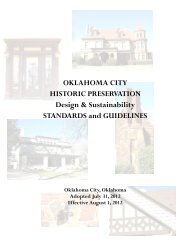The Cost of Homelessness in Oklahoma City April 1, 2009 to March ...
The Cost of Homelessness in Oklahoma City April 1, 2009 to March ...
The Cost of Homelessness in Oklahoma City April 1, 2009 to March ...
You also want an ePaper? Increase the reach of your titles
YUMPU automatically turns print PDFs into web optimized ePapers that Google loves.
<strong>Oklahoma</strong> <strong>City</strong> <strong>Cost</strong> <strong>of</strong> <strong>Homelessness</strong> Study <strong>2009</strong>‐2010<br />
We were able <strong>to</strong> f<strong>in</strong>d this man’s cost records at two <strong>of</strong> the seven area hospitals: St.<br />
Anthony’s and OU Medical Center. St. Anthony’s reported that they saw him <strong>in</strong> their<br />
Emergency Room 40 times dur<strong>in</strong>g our study period for a cost <strong>of</strong> $30,575. EMSA records<br />
show they <strong>to</strong>ok him <strong>to</strong> Integris South five times dur<strong>in</strong>g our study period, but we could not<br />
f<strong>in</strong>d him <strong>in</strong> their cost records. OU Medical Center’s records for the first eight months <strong>of</strong> the<br />
study period show they served him <strong>in</strong> their Emergency Room n<strong>in</strong>e times for a cost <strong>of</strong><br />
$11,600. EMSA records show they <strong>to</strong>ok him <strong>to</strong> OU 47 times dur<strong>in</strong>g the whole study period,<br />
so it is likely that the actual cost <strong>to</strong> OU was much higher than the amount we were able <strong>to</strong><br />
identify. Also, while this man has multiple health problems <strong>in</strong> addition <strong>to</strong> his chronic<br />
alcoholism, dur<strong>in</strong>g the <strong>Cost</strong> Study year hospital data showed only Emergency Room visits –<br />
no <strong>in</strong>patient or outpatient services. Sometimes, there was no charge, as he left before be<strong>in</strong>g<br />
seen.<br />
<strong>The</strong>re was no evidence that this chronically homeless man received help from the homeless<br />
service system dur<strong>in</strong>g the <strong>Cost</strong> Study period; he was not found <strong>in</strong> <strong>Oklahoma</strong> <strong>City</strong>’s HMIS<br />
system any time s<strong>in</strong>ce 2003, when the current system was implemented. <strong>The</strong> <strong>Cost</strong> Study<br />
Committee surmises that this man is not be<strong>in</strong>g served <strong>in</strong> the homeless system because he<br />
will not (or cannot) s<strong>to</strong>p dr<strong>in</strong>k<strong>in</strong>g and has not been <strong>in</strong>terested <strong>in</strong> follow<strong>in</strong>g the rules as they<br />
currently exist. While the person we studied may or may not be typical <strong>in</strong> his length <strong>of</strong> time<br />
homeless and <strong>in</strong> his level <strong>of</strong> <strong>in</strong>teraction with the police, EMSA and emergency rooms, his is<br />
actually quite a common experience for many chronically homeless persons <strong>in</strong> <strong>Oklahoma</strong><br />
<strong>City</strong> (there were 264 <strong>of</strong> them <strong>in</strong> the January 2010 PIT count).<br />
Mak<strong>in</strong>g recommendations is not under the purview <strong>of</strong> this study. However, the <strong>Cost</strong> Study<br />
Committee did want <strong>to</strong> make reference <strong>to</strong> a type <strong>of</strong> supportive hous<strong>in</strong>g that targets<br />
chronically homeless persons like the one we studied. Accord<strong>in</strong>g <strong>to</strong> several national and<br />
regional studies <strong>in</strong> the past ten years, the Hous<strong>in</strong>g First model <strong>of</strong> permanent supportive<br />
hous<strong>in</strong>g (which does not require sobriety or mental health stability) has an average success<br />
rate <strong>of</strong> about 75% (mean<strong>in</strong>g the people stay <strong>in</strong> the hous<strong>in</strong>g for more than 12 months) and<br />
has been shown <strong>to</strong> decrease the level <strong>of</strong> hospitalization, <strong>in</strong>carceration and crises, thereby<br />
sav<strong>in</strong>g many public and private dollars. <strong>The</strong> average cost <strong>of</strong> one Hous<strong>in</strong>g First unit <strong>of</strong><br />
permanent supportive hous<strong>in</strong>g is about $10,000.<br />
Spangler & Associates, Inc. Page 35

















